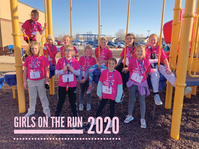How can we help others?
That was a question posed to a group of 12 girls in grades 3-5 at Sacred Heart Elementary in Yankton last fall during a ‘compromise’ lesson as part of the Girls on the Run program.
Really think about it, the girls were told.
Any idea is a good idea, they were told.
Even with the coronavirus pandemic still affecting everyday life, there are still ways you can help someone else, they were told while discussing an upcoming community impact project.
“We encouraged them to think outside the box and think about how we can make an impact when everyone is dealing with the virus,” said Jessica Wolles, a fourth grade teacher at Sacred Heart and coach for the school’s Girls on the Run team.
What the girls settled on took both tips to heart, according to Wolles.
They wanted to either write letters or design posters for residents at Avera Sacred Heart Hospital, Majestic Bluffs assisted living facility and the sisters at Sacred Heart Monastery, and they ultimately decided on the posters.
“We talked about the fact that the residents are essentially stuck where they’re at with the virus,” said Wolles, who completed her fifth year as a trained coach with Girls on the Run. “They were great places that could use that glimmer of happiness in the hallways.”
Each year, the various Girls on the Run teams at schools across the country (including Yankton, since 2015) spend 10 weeks discussing various lessons that all tie in, in some way, to a physical activity. The program, for girls in grades 3-5, teaches “life skills through dynamic interactive lessons and running games” and concludes with a 5K running event.
The goal of the program, according to one website, is to “unleash confidence through accomplishment while establishing a lifetime approach of health and fitness.”
“It’s not just physical health choices like eating healthy or exercising, but how to be a good friend and having confidence in yourself,” Wolles said.
Girls on the Run coaches and other volunteers call that a person’s ‘Star Power’ — that each star in the sky is unique, and that nobody and nothing can take away a person’s brightness.
Each day’s gathering (and the teams meet twice a week) is usually structured around that day’s specific lesson and the girls then conclude with a run. The lessons, according to Wolles, typically build on each other: For example, if one day they discuss their community, the next meeting would discuss ways to help their community.
“While they’re running, they’re thinking about something we talked about and how they can use that in their life,” Wolles said.
There’s also a community impact project the teams work on each year, and this year,
Sacred Heart’s team chose to design motivational posters for residents at the hospital, nursing home and monastery.
It answered the question, ‘who would really benefit from these posters?, the girls decided.
“At Sacred Heart, we talk quite a bit about serving others, and it was so cool to show the girls that even though there are limitations right now, we can still do that in more creative ways,” Wolles said.
Each member of the Sacred Heart team was responsible for a certain aspect of the project: Some looked up positive quotes and Bible verses that could be used, some were in charge of paper and some discovered creative font/designs.
When the team gathered, everyone grabbed a poster board and went to work.
“It was so neat to see the fellowship with each other,” Wolles said. “They were working together and building their team.”
In the end, the Sacred Heart group created approximately 20 posters that were eventually delivered to the three locations. “I know the sisters were very excited and happy, and we heard that they put some of the posters in their dining room,” Wolles said.
Beyond the opportunity to serve others, the Girls on the Run program (which has a fall and spring season) provides the girls a chance to better themselves, according to Wolles.
“My biggest hope is that they find self-confidence in making choices to make them the best people God created them to be,” she said.
And Wolles added that she has seen first-hand that the program has a positive influence on the girls involved. One year, a young girl — in her second year with Girls on the Run — proudly told Wolles that she found new friends, and that the people she spent time with the previous year “weren’t good friends.”
“She was glowing,” Wolles said. “That was a really proud moment. I thought, ‘This is what it’s all about.’”



